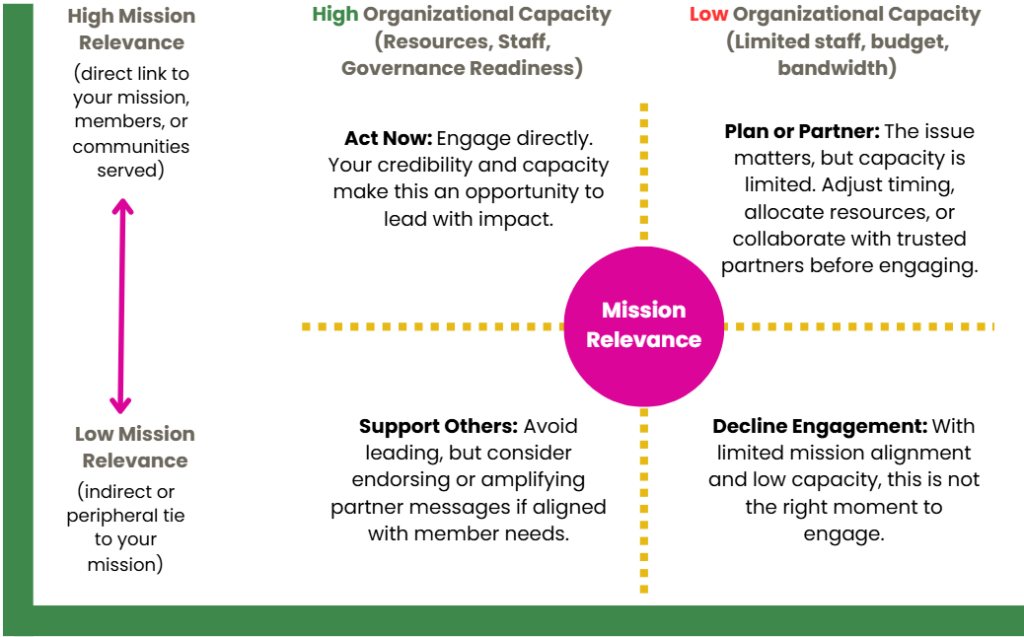
Scientific and professional associations today operate in an environment shaped by external pressures, shifting public discourse, and rapid cultural change. From research funding and public health priorities to ethics and access to care, these forces create both opportunity and risk—pushing association boards to consider when to engage publicly and when to hold back.
Common Triggers for Association Engagement
- Urgent legislation or regulatory changes that directly affect your field
- Funding shifts or announcements impacting research, education, or services
- Misinformation or high-profile media narratives misrepresenting your science
- Member safety, ethics, or standards-of-care concerns
- Major court decisions with clear professional implications
For nonprofit board leadership, the central question is rarely simple: when should the association speak out, and when should it remain silent?
Public engagement can demonstrate leadership, align the association with its mission, and support members in critical moments. But it can also strain relationships, divert attention from core priorities, or commit resources beyond capacity. At the same time, silence carries its own risks, as members, partners, and the public increasingly expect associations to address issues that affect their profession, their science, and the communities they serve.
Why This Matters for Governance and Strategy
The right public engagement strategy protects three essential aspects of long-term organizational health:
- Mission integrity: Keep every action anchored to the purpose your association exists to fulfill.
- Credibility and trust: Establish your organization as a reliable, respected voice in your field.
- Sustainable influence: Select moments and messages that strengthen your ability to shape meaningful change over time.
PMG is a trusted partner to association boards and nonprofit leaders, providing advocacy best practices and governance frameworks that balance mission integrity with reputational risk. In our work with scientific and professional associations, we’ve seen how the right process transforms high-pressure situations into opportunities for leadership, credibility, and lasting impact.
The Role of Your Mission in Decision-Making
Your mission is the most effective filter for determining when to engage publicly. If an issue directly connects to your mission, it may warrant consideration. If the connection is indirect or unclear, carefully assess whether engagement strengthens—or distracts from—long-term goals.
PMG helps boards frame every decision around three core questions:

The Engagement Readiness Matrix
 Before engaging publicly, boards should assess mission alignment and organizational capacity. This matrix prevents reactive decisions by clarifying when to act boldly, when to collaborate, and when to step back, ensuring every engagement is mission-driven, credible, and sustainable. PMG helps boards apply this tool consistently so even high-pressure choices remain deliberate and aligned with long-term strategy.
Before engaging publicly, boards should assess mission alignment and organizational capacity. This matrix prevents reactive decisions by clarifying when to act boldly, when to collaborate, and when to step back, ensuring every engagement is mission-driven, credible, and sustainable. PMG helps boards apply this tool consistently so even high-pressure choices remain deliberate and aligned with long-term strategy.
Impacts of Public Engagement
Public engagement is not inherently risky, but it is rarely neutral. For scientific and professional associations, public positions can amplify your voice and reinforce your mission’s relevance, but they also bring complexity across five dimensions:
- Operational impact: Developing, approving, and coordinating a public statement diverts staff and volunteer time from core activities.
- Financial impact: Engagement can attract mission-aligned support or alienate certain sponsors, while also requiring unplanned resources for legal review, media relations, or advocacy.
- Strategic impact: Well-aligned engagement strengthens leadership in your field; poorly aligned statements risk fragmentation and mission drift.
- Cultural impact: Engagement can unite members around shared values—or create tension when perspectives differ across disciplines, geographies, or contexts.
- Reputational impact: Purposeful, evidence-based engagement enhances visibility and credibility. Reactive or poorly framed engagement erodes trust and undermines years of reputation-building.
PMG has guided boards through each of these dimensions, helping them weigh benefits and risks in real time, often under significant public or member pressure.
Best Practices for Navigating Public Engagement
For most associations, the question is not if a decision on public engagement will be needed, but when. The pace of policy change, shifting public conversations, and emerging professional issues ensures every board will face moments when taking a position, or choosing not to, has real consequences. Preparing in advance ensures those decisions are made with alignment and confidence.
PMG recommends:
- Establish a decision framework with clear criteria for mission relevance, member impact, and resource availability.
- Use the strategic plan as a guidepost so engagement decisions align with long-term priorities rather than short-term events.
- Define a clear approval process for which statements require board approval and which may be issued by designated officers.
- Communicate transparently about why an issue matters to the association, its members, and the communities it serves.
- Plan for follow-through to ensure capacity for sustained action beyond the initial public statement.
- Evaluate each engagement by reviewing outcomes, member feedback, and external responses to refine future approaches.
- Leverage partnerships with credible organizations to strengthen messages, expand reach, and reduce risk.
PMG formalizes these practices through facilitation, templates, and evaluation tools, helping boards respond faster, with greater unity, and stronger public credibility.
Deciding How to Engage: Solo or Partnership
When readiness criteria are met, the next decision is how to engage. Sometimes the most credible voice is your own. Other times, collaboration with trusted partners strengthens impact and reduces risk.
EXAMPLES OF SPEAKING ALONE
- Issuing a statement on new research findings that directly impact your members
- Providing expert commentary in response to misinformation in the media
- Publishing a position paper to clarify the association’s stance on a critical professional or ethical standard
- Responding to sudden policy changes that affect your members’ ability to practice or conduct research
EXAMPLES OF PARTNERING WITH OTHERS
- Joint advocacy for federal research funding with other specialty societies
- Co-signing a public health or professional guidance statement with peer organizations
- Endorsing a coalition’s position paper on ethical standards or workforce training
- Collaborating on equity in access initiatives with patient advocacy groups
- Submitting joint comments on proposed legislation or regulations
- Partnering with allied organizations on emerging scientific or technological issues
Closing Takeaway: Leading with Mission, Supported by PMG
Public engagement is never about reacting in the moment. Successful boards align every decision with their mission to protect credibility, and ensure the capacity for follow through.
Associations that thrive are those that prepare in advance, apply clear frameworks, and engage selectively to maximize long-term influence while minimizing risk.
PMG partners with boards to make this possible. By providing governance frameworks, decision-making tools, and partnership strategies, we help associations navigate complex challenges with clarity, unity, and confidence. Our goal is to always help turn high-pressure moments into opportunities for mission-driven leadership.
